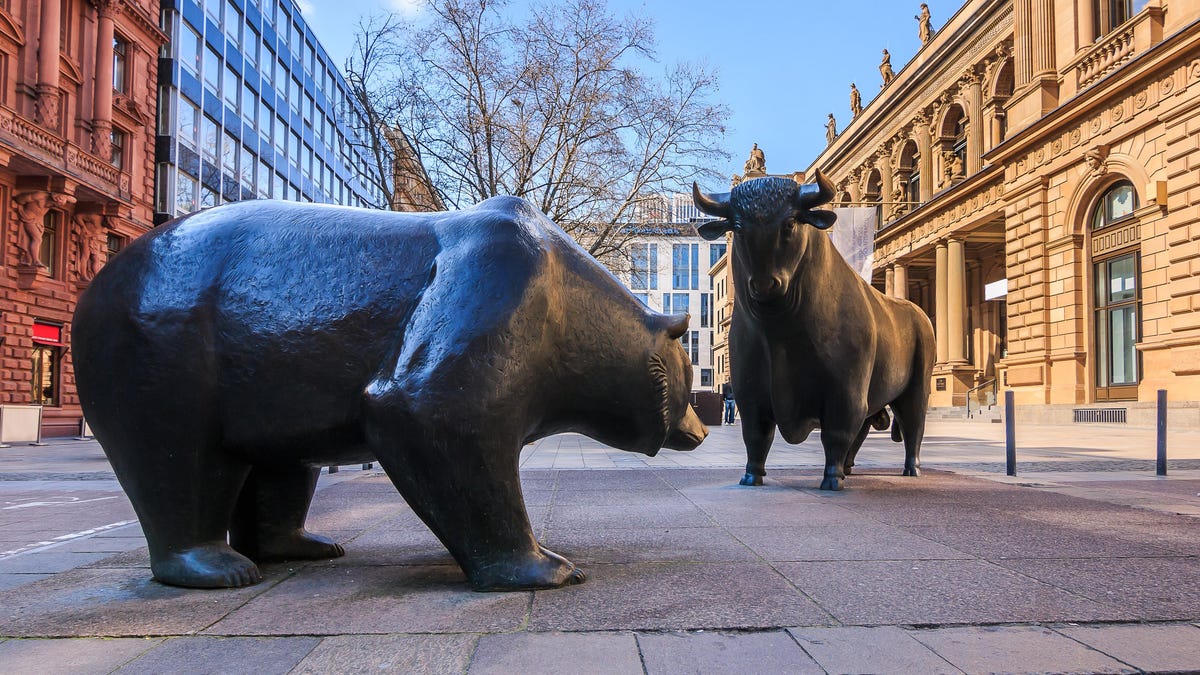8 of the Most Consequential Bear Markets in U.S. History (and What We Can Learn From Them)
As of this week, we are officially in a bear market. The S&P 500 has lost more than 20% of its value, with some tech stocks taking a much more severe beating than that—Netflix is tanking and Amazon’s stock...


Photo: Marco Ritzki (Shutterstock)
As of this week, we are officially in a bear market. The S&P 500 has lost more than 20% of its value, with some tech stocks taking a much more severe beating than that—Netflix is tanking and Amazon’s stock has dropped nearly 40%.
Bleak, right? Maybe. Maybe not. The United States has weathered around 14 bear markets (depending on how you define “bear”) since the end of World War II, and only about half of them lead to a recession. Below are eight instructive historical bear markets, and some the lessons we might learn from each.
But in the big picture, one extremely important lesson carries through them all: You probably shouldn’t even worry about it. Investing should be considered a long-game, and these things happen. Imagine the hypothetical unluckiest investor in the world, who spent the last 50 years investing in the stock market only on the days right before market dropped—they’d still come out way ahead in the long run, as long as they kept their money in the market.
(Another important lesson: Don’t look at your 401(k) until things straighten out.)
2 / 10
The crash of 1929 and the Great Depression
The crash of 1929 and the Great Depression

In London in October 1929, traders watch fluctuations in the New York stock market during the Wall Street crash.Photo: London Express (Getty Images)
Let’s start with the crash of ‘29, the biggest, baddest bear market in American history, and the economic worst-case-scenario that kicked off the Great Depression. Beginning with the crash in October 1929, the market slid downhill for three years, losing 90% of its value by 1932. The resulting economic fallout was a truly civilization-shaking event; in the U.S., the economy shrank by 50%, a third of all banks failed, and unemployment topped 25%. (And you think things are bad now?) It wasn’t until 1945 that the economy recovered to pre-crash levels.
What we can learn from the Great Depression: Things are not likely to get that bad again (at least not in the same way). We’re in a different financial world now. Our currency is no longed backed by gold, so liquidity is assured. Bank deposits are federally insured. We would be unlikely to respond to an economic downturn by limiting international trade or raising taxes, as we did after the crash (at least I hope we’re not that dumb). And the government and federal reserve are actually pretty good at working together to prevent utter disaster—see the bailouts of 2008 and 1987, which I’ll get to shortly.
The “baby bear” of 1966

Photo: GobyOneKenobi (Shutterstock)
If the Great Depression is the worst-case-scenario, the “baby bear” market of 1966 might be a best-case one. The market began a slide from a high of 94.06 on Feb. 9 to a low of 74.53 on Aug. 29, but it recovered quickly—seven months later, it was back above 94. The entire boom-to-bust and back cycle occurred in around 450 days; the recovery took about half as long as average.
What we can learn from the baby bear market: Sometimes we don’t know what causes a drop in stock prices. There are theories about the cause of the baby bear market—Wall Street overreacted to the Vietnam War, the Fed tightened the money supply—but no one actually knows for sure.
The “bear-free” 1990s

Illustration: tsuponk (Shutterstock)
The 1990s remains the only decade since the 1920s in which there were no bear markets at all. Stocks came close to shedding 20% of their value a few times, but never fully hit that magic number; the bulls ruled for a full decade. Should we thank Bill Clinton? The emergence of grunge? It’s hard to say. The prosperity of the time was fueled by emerging technologies that propelled an ever-expanding economy, as more and more people “bought in” to the promise that we’d all be able to ride the wave of growth forever. It seemed like the good times would never end! Until…
What we can learn from the bear free 1990s: “Nothing bad will ever happen again, right?” Cough cough.
The dotcom crash of 2000

Photo: Vladimir Ya (Shutterstock)
In the years leading up to the 2000 crash, excited venture capitalists poured money into tech companies, and investors poured money into tech stocks. Then more “civilians” started trading as well, not wanting to miss out on the gravy train. When it all went to hell, it went to hell fast (with the crash) and then painfully slowly—it took the market two and a half excruciating years to reach its rock bottom.
What we can learn from the dotcom crash: People can make money on assets bubbles, but you are not likely to be one of those people. It’s almost definitely a bad idea for the average person to try to make quick bank in a hot market, or buy stocks based on hype. Learn how to realistically understand the value a stock before you invest in it—or, better yet, let the professionals handle your money.
6 / 10
The stagflation, malaise, and bear markets of the 1970s
The stagflation, malaise, and bear markets of the 1970s

Photo: Dolores M. Harvey (Shutterstock)
Things were bad in the 1970s. Inflation was out of control. Unemployment was high. The national deficit was ballooning. Gas prices were nearing a whole dollar a gallon. President Carter described it as “crisis of confidence” in a nationally televised speech so bleak, you have to read it to believe it. The recession at the center of the national malaise began with a stock market crash and bear market in 1973–1974.
Nailing down the exact causes of the economic unpleasantness 1970s is difficult, but many feel it was was caused, at least in part, by a too-low federal interest rate flooding the economy with dollars that eventually led to inflation, then “stagflation,” defined as a period in which both unemployment and inflation remain high. The eventual recovery came, for the most part, from the Fed completely changing course and sending the national interest soaring (for a time, the Fed funds rate reached a breathtaking 21%).
What we can learn from the recession of the 1970s: Sometimes economic cures can hurt almost as much as the disease, but you gotta bite the bullet. To bring down inflation, the Fed plunged the economy into a recession and spiked the unemployment rate to more than 10%.
Bonus lesson: If you are the president, don’t be like Nixon and appoint a treasury secretary with no background in economics who will later declare personal bankruptcy.
7 / 10
1987's “Black Monday” crash and bear market
1987's “Black Monday” crash and bear market

Photo: Gagat55 (Shutterstock)
Almost no one saw Black Monday coming. The go-go ‘80s were in full swing, greed was good, and the recession of the early part of the decade had been largely forgotten. But then a confluence of disparate economic factors (a tax bill that affected leveraged buyouts, high trade deficit numbers) caused some relatively minor market instability that snowballed into something much worse.
On Monday, Oct. 19, 1987, the bottom fell out of financial markets worldwide. U.S. markets dropped over 22% in a single day. The sell-off was so severe, computer systems crashed trying to handle all the sell orders, and money people feared the entire international financial system would collapse. But then...it didn’t. Within a week, U.S. markets had regained more than half their value, and they had recovered completely in less than two years. No recession. Just an extremely unpleasant week on Wall Street.
What we can learn from Black Monday: Alan Greenspan is a superhero. Catastrophe was averted largely due to the Federal Reserve’s move to open up a money firehose in order to insure financial institutions would not collapse, limiting the impact on the day-to-day economy of all of us normal people. You’d have missed it if you didn’t read the paper.
8 / 10
The Great Recession of 2007-2008
The Great Recession of 2007-2008

Photo: Lubos Chlubny (Shutterstock)
The economic downturn of the late 2000s was the worst since the Great Depression. A congressional committee subsequently determined the cause was mainly a lack of regulation of the packaging and sale of mortgage-backed securities, firms taking on too much risk, and excessive consumer borrowing (specifically, people investing in toxic mortgages.)
Most people didn’t understood that when it was happening, of course, but the situation was so bad that the Feds had to extend nearly 8 trillion dollars in loans to financial institutions and drop interest rates to nearly zero.
What we can learn from the great recession: Remember back in 2007 when it felt like the sky was falling? Every bear market feels like that to the people living through it, especially one marked by high unemployment and a huge wave of home foreclosures. But the bad times pass, eventually; the stock market, which had lost half its value by 2009, recovered to new heights by 2013—and kept climbing.
As a country, the tumult theoretically taught us a hard lesson about the importance of regulating financial institutions. The Great Recession lead directly to the passage of the Dodd-Frank Act, the most comprehensive set of market reforms since the 1930s. (Too bad the lessons didn’t stick: Much of Dodd-Frank was repealed in 2018.)
The bear market of 2022

Photo: Scott E Read (Shutterstock)
A combination of uncertainty brought on by the ongoing global health crisis and the Fed raising interest rates to tamp down inflation fueled by the supply chain crisis and pandemic stimulus—these are the most likely cause of our current economic downtown. We might soon enter a period of recession, but there’s reason to be hopeful the economy won’t shrink significantly in the coming months and years. Non stock-market economic indicators are relatively healthy: Unemployment remains low and there’s still a strong demand for housing, even if the market is cooling in response to recent mortgage rate hikes. Keep your fingers crossed.
What we can learn from 2022’s bear market: Nothing—yet. No one can see the future.

 Tekef
Tekef 
























.jpg&h=630&w=1200&q=100&v=f776164e2b&c=1)
.jpg&h=630&w=1200&q=100&v=f776164e2b&c=1)
.png)





